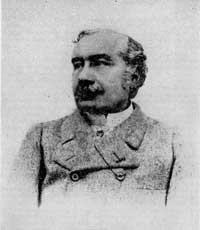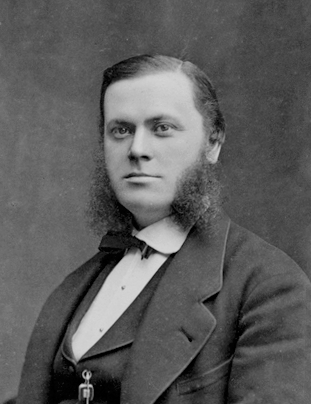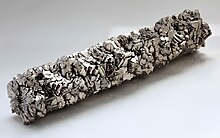Hafnium is a chemical element; it has symbol Hf and atomic number 72. A lustrous, silvery gray, tetravalent transition metal, hafnium chemically resembles zirconium and is found in many zirconium minerals. Its existence was predicted by Dmitri Mendeleev in 1869, though it was not identified until 1922, by Dirk Coster and George de Hevesy. Hafnium is named after Hafnia, the Latin name for Copenhagen, where it was discovered.

Scandium is a chemical element with the symbol Sc and atomic number 21. It is a silvery-white metallic d-block element. Historically, it has been classified as a rare-earth element, together with yttrium and the lanthanides. It was discovered in 1879 by spectral analysis of the minerals euxenite and gadolinite from Scandinavia.

Thulium is a chemical element; it has symbol Tm and atomic number 69. It is the thirteenth element in the lanthanide series of metals. It is the second-least abundant lanthanide in the Earth's crust, after radioactively unstable promethium. It is an easily workable metal with a bright silvery-gray luster. It is fairly soft and slowly tarnishes in air. Despite its high price and rarity, thulium is used as a dopant in solid-state lasers, and as the radiation source in some portable X-ray devices. It has no significant biological role and is not particularly toxic.

Dmitri Mendeleev published a periodic table of the chemical elements in 1869 based on properties that appeared with some regularity as he laid out the elements from lightest to heaviest. When Mendeleev proposed his periodic table, he noted gaps in the table and predicted that then-unknown elements existed with properties appropriate to fill those gaps. He named them eka-boron, eka-aluminium, eka-silicon, and eka-manganese, with respective atomic masses of 44, 68, 72, and 100.

Paul-Émile Lecoq de Boisbaudran, also called François Lecoq de Boisbaudran, was a self-taught French chemist known for his discoveries of the chemical elements gallium, samarium and dysprosium. He developed methods for separation and purification of the rare earth elements and was one of the pioneers of the science of spectroscopy.

Praseodymium is a chemical element; it has symbol Pr and the atomic number 59. It is the third member of the lanthanide series and is considered one of the rare-earth metals. It is a soft, silvery, malleable and ductile metal, valued for its magnetic, electrical, chemical, and optical properties. It is too reactive to be found in native form, and pure praseodymium metal slowly develops a green oxide coating when exposed to air.

Group 3 is the first group of transition metals in the periodic table. This group is closely related to the rare-earth elements. It contains the four elements scandium (Sc), yttrium (Y), lutetium (Lu), and lawrencium (Lr). The group is also called the scandium group or scandium family after its lightest member.

Per Teodor Cleve was a Swedish chemist, biologist, mineralogist and oceanographer. He is best known for his discovery of the chemical elements holmium and thulium.

Group 4 is the second group of transition metals in the periodic table. It contains only the four elements titanium (Ti), zirconium (Zr), hafnium (Hf), and rutherfordium (Rf). The group is also called the titanium group or titanium family after its lightest member.

The periodic table is an arrangement of the chemical elements, structured by their atomic number, electron configuration and recurring chemical properties. In the basic form, elements are presented in order of increasing atomic number, in the reading sequence. Then, rows and columns are created by starting new rows and inserting blank cells, so that rows (periods) and columns (groups) show elements with recurring properties. For example, all elements in group (column) 18 are noble gases that are largely—though not completely—unreactive.

Carl Gustaf Mosander was a Swedish chemist. He discovered the rare earth elements lanthanum, erbium and terbium.

Baron Axel Fredrik Cronstedt was a Swedish mineralogist and chemist who discovered the element nickel in 1751 as a mining expert with the Bureau of Mines. Cronstedt is considered a founder of modern mineralogy, for introducing the blowpipe as a tool for mineralogists, and for proposing that the mineral kingdom be organized on the basis of chemical analysis in his book Försök til mineralogie, eller mineral-rikets upställning.

Jacques-Louis Soret was a Swiss chemist and spectroscopist. He studied both spectroscopy and electrolysis.

Holmium(III) oxide, or holmium oxide is a chemical compound of the rare-earth element holmium and oxygen with the formula Ho2O3. Together with dysprosium(III) oxide (Dy2O3), holmium oxide is one of the most powerfully paramagnetic substances known. The oxide, also called holmia, occurs as a component of the related erbium oxide mineral called erbia. Typically, the oxides of the trivalent lanthanides coexist in nature, and separation of these components requires specialized methods. Holmium oxide is used in making specialty colored glasses. Glass containing holmium oxide and holmium oxide solutions have a series of sharp optical absorption peaks in the visible spectral range. They are therefore traditionally used as a convenient calibration standard for optical spectrophotometers.

Alexandre-Émile Béguyer de Chancourtois was a French geologist and mineralogist who was the first to arrange the chemical elements in order of atomic weights, doing so in 1862. De Chancourtois only published his paper, but did not publish his actual graph with the irregular arrangement. Although his publication was significant, it was ignored by chemists as it was written in terms of geology. It was Dmitri Mendeleev's table published in 1869 that became most recognized. De Chancourtois was also a professor of mine surveying, and later geology at the École Nationale Supérieure des Mines de Paris. He also was the Inspector of Mines in Paris, and was widely responsible for implementing many mine safety regulations and laws during the time.

Christian Wilhelm Blomstrand was a Swedish mineralogist and chemist. He was a professor at the University of Lund from 1862-1895, where he isolated the element niobium in 1864. He developed an early version of the periodic table and made advances in understanding the chemistry of coordination compounds. Blomstrand published textbooks in chemistry and was well-known internationally for his scientific contributions.

Henrik Gustaf Söderbaum was a Swedish chemist and secretary of the Royal Swedish Academy of Sciences from 1923 to 1933.

Baron Jöns Jacob Berzelius was a Swedish chemist. In general, he is considered the last person to know the whole field of chemistry. Berzelius is considered, along with Robert Boyle, John Dalton, and Antoine Lavoisier, to be one of the founders of modern chemistry. Berzelius became a member of the Royal Swedish Academy of Sciences in 1808 and served from 1818 as its principal functionary. He is known in Sweden as the "Father of Swedish Chemistry". During his lifetime he did not customarily use his first given name, and was universally known simply as Jacob Berzelius.

Lars Fredrik Svanberg was a Swedish chemist and mineralogist.




















